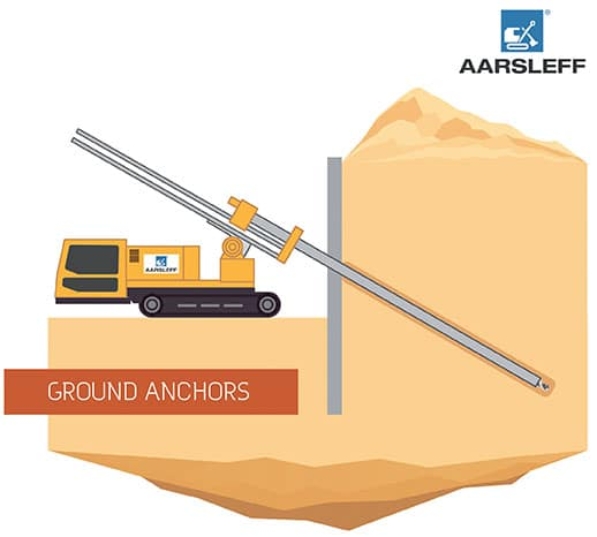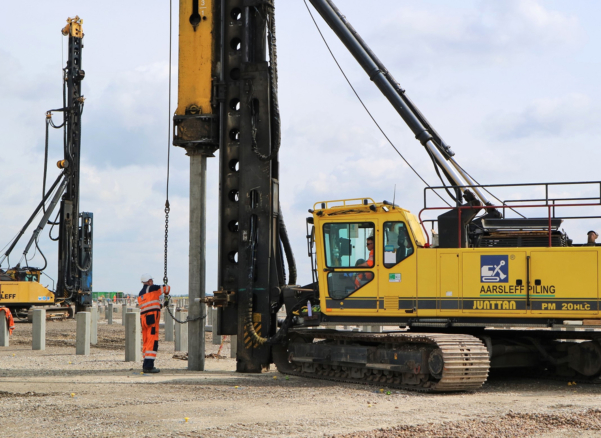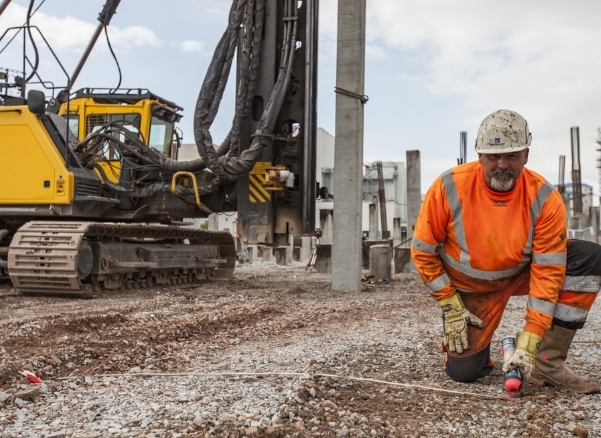What Are Ground Anchors?
Table of Contents
- How Does Ground Anchors Work?
- What Is The Purpose of Ground Anchors?
- Other Applications of Ground Anchors
- How Are Ground Anchors Installed?
- Why Should Ground Anchors Be Used?
How Does Ground Anchors Work?
A ground anchor, also known as an earth anchor, is a load transfer system designed to transfer the forces applied to it to a competent stratum. These versatile devices are used to hold, restrain and support buildings and other structures, either permanently or temporarily. Ground anchors can carry very high loads to hold down/up/back structures or slopes. They can be utilised as either a permanent or temporary component of any construction or civil engineering project. Heavy-duty ground anchors come in various types and sizes, up to 70 metres in length with capacities of over 3,000 kN. [1]
Ground anchors are applied to an engineered system that mechanically fixes a structure to the ground, enabling load transfer into a competent stratum. The shear strength of the surrounding soil resists the tensile forces applied.

History of Ground Anchors
The world’s first practical ground anchor was invented in 1912 by Albert Bishop Chance. A disastrous storm hit Centralia in Missouri and damaged the telephone system managed by Mr. Chance. New telephone poles had to be put in, new wire strung and almost every pole had to be straightened and re-anchored. There wasn’t time for deadman anchor installations. Mr. Chance invented the anchor, later known as the “Never-Creep.”
Originally, this anchor consisted of half of a 2ft length of pole with a hole through the middle for the rod. The rod had an eye-hand forged and welded by a blacksmith. It was fitted with a threaded end and nut with no galvanizing. The rod was driven to hit a pre-drilled anchor hole. The log anchor was held in the hole by one lineman lying on the ground while a second lineman pushed on the rod until it threaded the hole. The nut was held by a wired device on the end of a broom handle while the rod was rotated to engage the thread. [2]
What Is The Purpose of Ground Anchors?
The primary purpose of geotechnical ground anchors is to prevent horizontal movement while stabilising retaining structures, including sheet piles, bored concrete piles and steel tubular walls. With the capability to be either passive or pre-stressed to 110% of the working load post-installation, ground anchors can be installed either vertically or in an inclined position. [3]

Other Applications of Ground Anchors
Ground anchors can prevent additional movement or stabilise existing retaining walls or bridge abutments. Let’s look at some examples where ground anchors can be used:
- Slope and embankment stabilisation
- Erosion control
- Anchored retaining walls
- Gabion support structures and anchored gabion applications
- Slope and retaining wall drainage (when combined with an Anchor Drain)
- Retaining sheet piling
- Retaining bridge abutments
- Landfill capping when installed and combined with geotextiles
- Retaining temporary work structures
- Back staying scaffolding
- Structural stabilisation and support
Other applications of ground anchors could be in cofferdams, where internal bracing causes construction problems, in dock walls and marine structures, where dock walls need to be stabilised and strengthened, and on river and canal walls, as tiebacks.
How Are Ground Anchors Installed?
The installation of ground anchors requires a 10-step construction process:
- Develop the most effective and efficient design, including the type of anchors to be used and where they should be installed
- Set up the drill rig and drill the required hole size and depth
- Inject grout
- Insert threaded bar with sleeve
- Apply the plate
- Once the grout has hardened, apply load to the end of the anchor and try to pull it out. This will verify that you have installed the ground anchor correctly, and it will do what it’s supposed to do.
- Drainage strips
- Install temporary facing
- Install the toe drain
- Install final facing
For more information on installing ground anchors, watch our dedicated video:
Why Should Ground Anchors Be Used?
Ground anchors are an excellent solution for slopes and embankments, but in comparison to alternative methods, there are many advantages such as:
- Practical alternative to propping
- Versatile form of earth retention
- High loads can be obtained in relatively poor ground conditions
- Driven anchors can be used in a variety of soil conditions
- They are used to install ‘active’ forces into structures
- Enhanced durability, including resistance to corrosion and resistance to alkalis and solutions in soils, increases their life and significantly reduces the need for maintenance, thereby decreasing life-cycle costs
- Driven anchors create a low environmental impact
- Permanent anchors are frequently used in new ports and harbour developments, road schemes, dam refurbishments and tensile support
- Maximised working spaces can be created for deep excavations on civil engineering projects such as cofferdams, new builds or extensions, cut and cover tunnels, to name a few
- Can produce valuable savings in programme and budget
Sources
- Design Buildings. (2020). Ground Anchors. Retrieved 3rd December 2024, from
https://www.designingbuildings.co.uk/wiki/Ground_anchor - Hubbell Power Systems. (2013). Encyclopedia of Anchoring. Retrieved 3rd December 2024, from:
https://hubbellcdn.com/literature/049401A.pdf - Geotechnical Engineering. (2020). Ground Anchors. Retrieved 3rd December 2024, from:
https://www.geotech.net.au/capabilities/ground-anchors.html








